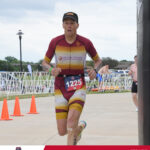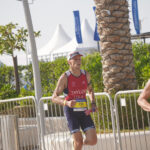An unfortunate reality of being a committed triathlete is that you will likely experience minor, yet nagging, injuries with some frequency during the course of your triathlon career. You know what I’m talking about. Those little injuries that don’t involve serious physical trauma to muscles, tendons, or bones (usually just a pull rather than a tear). They aren’t serious enough to require significant medical attention or extended time off. But they hurt and can continue to hurt for weeks or months despite not preventing you from training or racing.
Those little injuries that don’t involve serious physical trauma to muscles, tendons, or bones (usually just a pull rather than a tear). They aren’t serious enough to require significant medical attention or extended time off. But they hurt and can continue to hurt for weeks or months despite not preventing you from training or racing.
Since my return to triathlon in 2019 after an 11-year hiatus, I’ve had more than my share of both niggling and serious injuries. In early 2020 and 2021, I missed close to six weeks of running each off-season  dealing with Hoffa’s Fat Pad Syndrome. Also, over the last few years, I’ve had a pulled right hamstring that kept me from running for weeks at a time. I’ve also had an Achilles injury that I truly thought was the end of my season in 2023, yet it healed surprisingly quickly, and I was able to get back to training within a week.
dealing with Hoffa’s Fat Pad Syndrome. Also, over the last few years, I’ve had a pulled right hamstring that kept me from running for weeks at a time. I’ve also had an Achilles injury that I truly thought was the end of my season in 2023, yet it healed surprisingly quickly, and I was able to get back to training within a week.
I’ve also had direct experience with more serious injuries. In September, 2021, I was hit by a car during a training ride and there was no gray area there. I broke several bones in my right leg (thankfully no surgery) and was on crutches for seven weeks before working my way back to full health and fitness during the 2022 race season.
The minor injuries can be so frustrating because it isn’t always clear what the best course of action or treatment is. In some ways, minor injuries can be more troubling. Miguel Mattox, the 2nd year pro triathlete, who recently crashed on his bike, breaking four bones in his right shoulder requiring surgery, remarked that serious injuries are easier than nagging injuries in some ways because there is absolute clarity on what needs to be done (assuming you have a good sports orthopedist and a confident diagnosis): stop training, have surgery, let the injuries heal, progress through a structured rehabilitation protocol, return to triathlon training when nearly fully healed, and, finally, return to racing when the injuries have fully healed and you have regained your fitness.
remarked that serious injuries are easier than nagging injuries in some ways because there is absolute clarity on what needs to be done (assuming you have a good sports orthopedist and a confident diagnosis): stop training, have surgery, let the injuries heal, progress through a structured rehabilitation protocol, return to triathlon training when nearly fully healed, and, finally, return to racing when the injuries have fully healed and you have regained your fitness.
In contrast, nagging injuries fall into a gray area in which it isn’t clear what is the best path forward. And, of course, when an injury occurs, there is no way to tell initially whether it is serious or not. This  uncertainty is especially scary because a more serious injury could mean the end of the triathlon season and death of all our competitive goals for the season. As humans, we tend to go right to the catastrophic possibility as a way of preparing ourselves psychologically and emotionally for the worst-case scenario.
uncertainty is especially scary because a more serious injury could mean the end of the triathlon season and death of all our competitive goals for the season. As humans, we tend to go right to the catastrophic possibility as a way of preparing ourselves psychologically and emotionally for the worst-case scenario.
What’s often mystifying about these types of injuries is that they often come out of nowhere. With some injuries, they often result from weaknesses that we already knew existed, for example, weak hamstrings or irritation from a previous injury that was more serious. I’ve had these unpleasant surprises happen to me twice in the last year.
First, in the spring of 2023, when just walking around my house, I heard and felt a pop in my left Achilles, followed by acute pain. In all my years of running, I have never had a problem with my Achilles. Having known people who tore their Achilles tendon (it is excruciatingly painful, and you simply can’t walk), I knew that I didn’t tear it, but a search online revealed a wide range of possible severity. Plus, for the next several days, I could barely walk, and I truly thought my season was over. Yet, by the fourth day, the pain had subsided, I ran on it on the fifth day, and had no further repercussions the rest of 2023.
knew that I didn’t tear it, but a search online revealed a wide range of possible severity. Plus, for the next several days, I could barely walk, and I truly thought my season was over. Yet, by the fourth day, the pain had subsided, I ran on it on the fifth day, and had no further repercussions the rest of 2023.
Then, just a few weeks ago, I was out for an easy, 40-minute run. When I started out, I actually thought to myself how good I felt: easy stride, comfortable, flowing. Then, after less than a mile, I felt some pain in  my left groin. Within another 25 yards, my groin was so painful, I had to stop running and walk home. Like my Achilles, I have never had a groin injury in all my years of running.
my left groin. Within another 25 yards, my groin was so painful, I had to stop running and walk home. Like my Achilles, I have never had a groin injury in all my years of running.
You basically have several options when faced with the onset of an injury of uncertain severity.
Denial
Your immediate and almost instinctive reaction is deny the injury (the first stage in Kubler-Ross’s five-stages of grief) and to try to push through and hope that it was some freakish—and brief—occurrence. This reaction is never wise because it never alleviates the pain; rather, it usually just makes the injury worse. I strongly recommend that, if you feel this urge, you use every brain cell in your rational mind to resist its Siren’s Call of denial!
Rest
The best initial option is to just stop what is causing the pain and wait till the next day before you make any decisions about how best to proceed. During this timeframe, you will see if there is any swelling or bruising, or if the pain subsides significantly compared to the day before.
Then I would recommend that you rest it for a solid few days. This response will often tell you how serious the injury is. If, after a few days, the pain has lessened noticeably, it’s a pretty safe bet that the injury isn’t serious (what a relief!) and will heal relatively quickly (though the term ‘quickly’ can mean a few days or a few weeks).
serious (what a relief!) and will heal relatively quickly (though the term ‘quickly’ can mean a few days or a few weeks).
Importantly, depending on the location of the injury, resting doesn’t necessarily mean lying in bed and doing nothing at all. Losing fitness (and, for some, gaining weight) is a huge source of worry and angst to carry while healing from an injury.
Through all of my nagging injuries (caused by running), I was able to continue all of my training (swim,  bike, some strength) except running. For example, with my recent groin injury, it wasn’t a problem for me to bike and swim, and, amazingly, it didn’t hurt at all when I did squats and dead lifts with heavy weights (though it did hurt when I tried to do lunges and split squats, so I didn’t do those).
bike, some strength) except running. For example, with my recent groin injury, it wasn’t a problem for me to bike and swim, and, amazingly, it didn’t hurt at all when I did squats and dead lifts with heavy weights (though it did hurt when I tried to do lunges and split squats, so I didn’t do those).
For both your physical fitness and your psychological equilibrium, I strongly recommend that you do everything you can to stay active and maintain your fitness around the injury.
Get a Professional Diagnosis
Though you will likely feel compelled to self-diagnose (this is one of the dangers of the internet where there is information, but not knowledge and experience), I would urge you from doing so. An online search of your symptoms will usually reveal a dizzying array of possible causes for your injury that in no way helps you identify its actual cause.
search of your symptoms will usually reveal a dizzying array of possible causes for your injury that in no way helps you identify its actual cause.
My experience has shown me that, unless you sustain an injury from some traumatic event, such as crashing on your bike or turning an ankle on a trail run, if you rest it for a few days, it will show signs of improvement that would indicate that the injury is minor and probably doesn’t require a visit to the sports-medicine doctor or a physical therapist’s office.
However, if the injury doesn’t improve in a few days, a professional opinion may be warranted. Seeing a professional can often provide clarity on what the specific injury is, what caused it, and the likely course of healing and return to training.
Nonetheless, you should be prepared for the fact that talking to a pro might not provide any clarity. For  my chronic knee pain from a few years ago, I talked to four different sports-medicine professionals, and none could provide a diagnosis beyond “knee irritation” (not very helpful!). It took a visit to Dr. Kevin Stone for my “car meets bike” incident who finally told me with confidence that it was the aforementioned Hoffa’s Fat Pad Syndrome and his recommended treatment was spot on as well.
my chronic knee pain from a few years ago, I talked to four different sports-medicine professionals, and none could provide a diagnosis beyond “knee irritation” (not very helpful!). It took a visit to Dr. Kevin Stone for my “car meets bike” incident who finally told me with confidence that it was the aforementioned Hoffa’s Fat Pad Syndrome and his recommended treatment was spot on as well.
Despite my above skepticism of seeking out experts, there can certainly be value in a visit to a qualified MD or PT because they might also offer some treatment and exercises that could facilitate healing. For me, it’s a calculus the benefit of new and useful information vs. the cost of paying for their services.
Listen to Your Body
Your body may be the best judge of the severity of an injury and how best to proceed with it. Your body has a tremendous capacity to communicate its status and needs to you. Unfortunately, as a serious triathlete, you may not be great at listening or, perhaps better expressed, you hear what you want to hear because the messages you get from your body are usually ones you don’t want to hear. Of course, what you want to hear is “You can start training again!” rather than what your body might actually be telling you, “We’re healing, but we’re not quite ready to go yet.” Plus, you may ignore your body’s messages because it whispers to you at first, assuming that you will listen. When you don’t, it increases the volume of its messages until it is screaming at you (in major pain!) and you have to listen.
The challenge with listening to your body is that it is difficult to judge what the messages mean in terms of immediate action or inaction. For example, if you only feel a little pain after a few days of rest, should you give it a test? How long should you rest the injury? And how long should you feel minimal pain or none at all before you return to training?
With my recent groin injury, I didn’t run for five days while continuing my other training at its previous level of volume and intensity. My groin was feeling mostly pain-free at that point, so I tried a short run, but only lasted about a mile when it began to hurt again (yes, I listened to my body and stopped!). I took another 3 days off from running and began a series of stretching and strengthening exercises involving the muscles at the top of my legs. Then, over the next five days, I ran a mostly pain-free easy 40 minutes, a low-intensity eight-mile run, and then a real test of an interval track workout. Through these three workouts, there was still some discomfort, but no messages from my body telling me to stop. Since then, I’ve had no pain and not even any awareness of the injury, with workouts that included several 90-minute runs and a hard track workout. It has now been around four weeks since the initial groin injury and I am pretty confident that I am healed, and the injury is completely behind me. To play it safe, I will continue my exercises to reduce the risk of re-injury. In the meantime, it’s full steam ahead as I prepare for Clash Miami in early March.
Under the category of “I practice what I preach,” I would say that, yes, I have!







